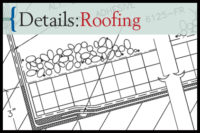Details: Pitch Pans

Pitch Pans
T he most common source of roof leaks is at vertical transitions and penetrations. Most designers provide adequate details to wall and curb flashings and common penetrations such as vents. Problems occur at mechanical support penetrations, multiple pipe penetrations or electrical conduit from mechanical equipment. It is not uncommon to see variations of waterproofing techniques at these types of penetrations. Problems can range from no waterproofing at all to misguided attempts to use wrapped membranes.Multiple pipe penetrations and conduits are ideal candidates for pitch pan applications. Pitch pans are fabricated from metal (or copper) that is set in two pieces and soldered to form a box around the penetration. Pitch pan boxes are applied over the completed membrane surface on BUR and single-ply roof systems and over the base ply on modified bitumen systems. The pitch pan flanges are covered over with a strip-in material or modified bitumen cap sheet. The metal flanges typically extend onto the membrane surface a minimum of 6 inches and the strip-in material should be applied a minimum of 6 inches beyond the flange.
The pitch pan boxes should be fabricated to a minimum height of 6 inches above the roof surface with a width to allow the penetration to be centered in the box. There are variations of fillers for pitch pans. The most effective filler is a combination of a quick grout applied as the base fill with pourable sealer applied over it. The fill should be tempered off at the top and should not exceed the box height.
A metal hood or “umbrella” should be fabricated as a covering for the box to prevent moisture from entering at the fill openings. The fill dissipates over time and separation of the material occurs from movement at these locations. The coverings also eliminate the need for the continual maintenance procedure of filling the sealer.
A metal clamping ring is used to attach the top of the covering to the penetration. Sealant is applied over the clamping ring to eliminate moisture infiltration at the top of the covering.
Looking for a reprint of this article?
From high-res PDFs to custom plaques, order your copy today!






